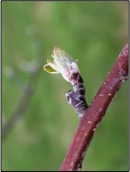Apple Disease Update: Half-Inch Green
go.ncsu.edu/readext?517578
en Español / em Português
El inglés es el idioma de control de esta página. En la medida en que haya algún conflicto entre la traducción al inglés y la traducción, el inglés prevalece.
Al hacer clic en el enlace de traducción se activa un servicio de traducción gratuito para convertir la página al español. Al igual que con cualquier traducción por Internet, la conversión no es sensible al contexto y puede que no traduzca el texto en su significado original. NC State Extension no garantiza la exactitud del texto traducido. Por favor, tenga en cuenta que algunas aplicaciones y/o servicios pueden no funcionar como se espera cuando se traducen.
Português
Inglês é o idioma de controle desta página. Na medida que haja algum conflito entre o texto original em Inglês e a tradução, o Inglês prevalece.
Ao clicar no link de tradução, um serviço gratuito de tradução será ativado para converter a página para o Português. Como em qualquer tradução pela internet, a conversão não é sensivel ao contexto e pode não ocorrer a tradução para o significado orginal. O serviço de Extensão da Carolina do Norte (NC State Extension) não garante a exatidão do texto traduzido. Por favor, observe que algumas funções ou serviços podem não funcionar como esperado após a tradução.
English
English is the controlling language of this page. To the extent there is any conflict between the English text and the translation, English controls.
Clicking on the translation link activates a free translation service to convert the page to Spanish. As with any Internet translation, the conversion is not context-sensitive and may not translate the text to its original meaning. NC State Extension does not guarantee the accuracy of the translated text. Please note that some applications and/or services may not function as expected when translated.
Collapse ▲Even with the cold snap this past week, most apple cultivars in Western NC are now at or have surpassed the green tip phenology stage. For cultivars that have made it to half-inch green or beyond, high rate copper applications should be discontinued (see previous green tip apple disease update post). During the HIG growth stage, protection of green tissue from apple scab should be the primary focus in regards to disease management for apple growers. Despite the cooler weather, Venturia inaequalis ascospores are continuing to mature. As of 3/23/18, ascospore maturity had reached 16% in Edneyville, NC (Gala green-tip: 2/28/18), and 9% of total ascopores are predicted to have been discharged. To date, there have been four apple scab infection events since green tip, as predicted by the Revised Mills Table (newa.cornell.edu). Ascospore maturity will usually progress slowly through tight cluster and then tends to most rapidly progress between pink bud and bloom.
Fungicide applications during HIG should be targeted at protecting emerging tissue from primary (ascospore) infection. For best control, multi-site protectant fungicide should be applied in tank mixture with a single-site, locally systemic fungicide. If a dormant oil was or will be applied for scale, do not apply captan at HIG, and instead use a 1/2 rate of an EBDC such as mancozeb. Syllit FL (1.5 pt) + Mancozeb (1/2 rate) is a good option for this growth stage because the active ingredient (dodine) is highly effective against apple scab but fails to appreciably control other apple diseases that occur later in the season. Due to the history of resistant scab populations to dodine, make sure to tank mix the product with mancozeb. Other warnings and restrictions on the Syllit FL label include limiting applications of the product to two applications/year, discontinuing applications at pink bud, and avoiding applying the the product with some coppers, sulfurs, and oil. Products containing an AP fungicide (FRAC 9) should also be considered at HIG as AP fungicides have been observed to be more effective in colder weather. Specific fungicides containing an AP include Scala, Vangard, and Luna Tranquility. Additional fungicide options can be found in the 2018 Integrated Orchard Management Guide for Commercial Apples in the Southeast.




